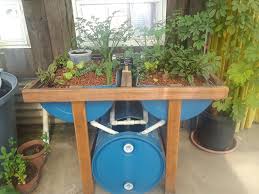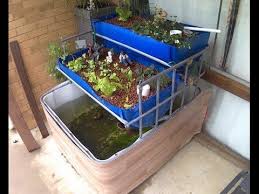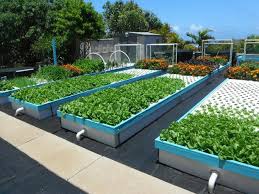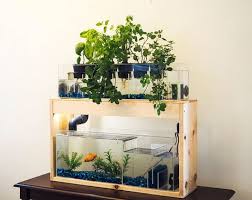Diy aquaponics system is an innovative method of farming that combines aquaculture (raising fish) with hydroponics (growing plants in water). This symbiotic relationship creates a sustainable ecosystem where both fish and plants thrive. As concerns over food security and environmental sustainability grow, many individuals are turning to alternative methods of food production. One increasingly popular option is the DIY aquaponics system, which allows anyone to create their own self-sustaining garden at home.
The basic premise of aquaponics involves the circulation of water between fish tanks and plant beds. Fish produce waste that is rich in nutrients. This waste is broken down by beneficial bacteria in the water into forms that plants can absorb. In turn, plants help filter and clean the water before it is returned to the fish tanks. This cycle not only ensures a healthy environment for both fish and plants but also maximizes the efficiency of water use, making aquaponics an environmentally friendly choice.
Creating a DIY aquaponics system can be a rewarding project, whether you’re looking to grow fresh vegetables, herbs, or even fish. This system can be set up in various spaces, from small balconies to larger backyards, making it versatile for different living situations. A well-planned aquaponics setup can yield a variety of crops, providing fresh produce year-round and reducing reliance on store-bought vegetables, which often come with a larger carbon footprint.
One of the greatest advantages of a DIY aquaponics system is its potential to reduce water consumption compared to traditional farming. Because water is recirculated within the system, it uses up to 90% less water than conventional agriculture. This is particularly beneficial in areas where water is scarce or where sustainable practices are a priority. Additionally, by growing your own food, you can enjoy fresher produce without the use of pesticides or herbicides, promoting a healthier lifestyle.
Setting up a DIY aquaponics system also offers an educational experience for individuals and families alike. It teaches valuable lessons about sustainability, biology, and ecology. Children and adults can learn about the interdependence of organisms and the importance of environmental stewardship. This hands-on approach encourages a deeper understanding of where food comes from and how it is grown, fostering a connection to the food we consume.
In terms of cost, starting a DIY aquaponics system can be budget-friendly, especially when utilizing recycled materials and local resources. Many components, such as fish tanks, grow beds, and water pumps, can be sourced affordably or even built from scratch. This not only saves money but also allows for a customizable experience tailored to individual preferences and available space.
While there may be challenges in setting up and maintaining a DIY aquaponics system, such as balancing water quality and ensuring proper nutrient levels, the rewards often outweigh the difficulties. With patience and a willingness to learn, anyone can successfully create a thriving aquaponics system that contributes to their food supply and promotes sustainable living.
Whether you are an experienced gardener or a beginner looking for a new hobby, a DIY aquaponics system presents a unique opportunity to engage with food production in a sustainable and innovative way.
Benefits of DIY Aquaponics Systems

1. Sustainable Food Production: DIY aquaponics systems combine fish farming and plant cultivation in a closed-loop system. This method utilizes fish waste as organic fertilizer for plants, minimizing the need for chemical fertilizers. It promotes sustainable food production by reducing resource consumption and waste.
2. Space Efficiency: Aquaponics systems can be set up in small spaces, making them ideal for urban gardening or limited areas. Vertical gardening techniques can be employed, allowing for maximum production in minimal space.
3. Reduced Water Usage: Aquaponics systems use significantly less water compared to traditional agriculture. The water circulates between the fish tank and plant beds, with minimal evaporation and loss, making it a more efficient method of water use.
4. Fresh and Organic Produce: Growing your own food in an aquaponics system ensures that you have access to fresh, organic produce. You can avoid harmful pesticides and chemicals, providing healthier food options for you and your family.
5. Educational Experience: Building and maintaining a DIY aquaponics system can be a valuable learning experience. It teaches principles of biology, ecology, and sustainability, making it a great project for schools, families, or individuals interested in gardening and aquaculture.
Essential Components of an Aquaponics System
1. Fish Tank: The fish tank is where the aquatic animals are raised. It should be appropriately sized for the number and type of fish you plan to keep. The tank must have a filtration system to maintain water quality and ensure the health of the fish.
2. Grow Beds: These are where the plants are grown. Grow beds can be made from various materials, including plastic, wood, or metal, and should have a growing medium (like gravel or clay pellets) to support plant roots while allowing for water circulation.
3. Water Pump: A water pump is essential for circulating water between the fish tank and the grow beds. It helps deliver nutrient-rich water from the fish tank to the plants and returns filtered water back to the fish tank.
4. Aeration System: An aeration system provides oxygen to the fish and helps maintain water quality. This can be achieved with air stones or diffusers connected to an air pump.
5. Plumbing System: A well-designed plumbing system connects all components, ensuring proper water flow and drainage. It typically includes pipes, fittings, and valves to control water movement.
6. Grow Lights (if indoors): If you are setting up your aquaponics system indoors or in low-light conditions, grow lights may be necessary to provide adequate light for plant growth.
Choosing the Right Fish for Your System
1. Tilapia: Tilapia are popular choices for aquaponics due to their hardiness, fast growth, and tolerance for varying water conditions. They thrive in temperatures between 75°F and 85°F, making them suitable for many regions.
2. Catfish: Catfish are another excellent option, known for their ability to adapt to different environments. They grow quickly and are a popular choice for aquaponics systems.
3. Trout: If you live in a cooler climate, trout may be a good option. They prefer colder water temperatures and are known for their high protein content, making them a nutritious choice.
4. Goldfish: For beginners, goldfish are a low-maintenance option. They are hardy, easy to care for, and can be used in smaller systems for ornamental purposes.
5. Koi: Similar to goldfish, koi are ornamental fish that can thrive in aquaponics systems. They are visually appealing and can help create a vibrant aquatic environment.
Read Also: Chiggers: Description, Damages Caused, Control and Preventive Measures
Selecting Suitable Plants for Aquaponics

1. Leafy Greens: Leafy greens such as lettuce, spinach, and kale are ideal for aquaponics systems. They grow quickly, require less space, and thrive in nutrient-rich water.
2. Herbs: Culinary herbs like basil, mint, and cilantro do well in aquaponics. They have high market value and can be harvested continuously, providing a steady supply of fresh herbs.
3. Fruiting Vegetables: Plants like tomatoes, peppers, and cucumbers can also thrive in aquaponics systems. However, they may require more attention and support as they grow larger and heavier.
4. Strawberries: Strawberries are a great addition to aquaponics due to their compact growth habit and high demand in the market. They can be grown in vertical systems, maximizing space.
5. Radishes: Radishes are fast-growing and require minimal space, making them an excellent choice for aquaponics systems. They can provide a quick harvest while improving soil quality in traditional growing systems.
Designing Your Aquaponics Setup
When designing your aquaponics system, consider the following key elements:
1. Space Requirements: Assess the space available for your setup. Whether you are working indoors, outdoors, or in a greenhouse, ensure that you have adequate room for all components, including the fish tank, grow beds, and plumbing.
2. System Type: Decide on the type of aquaponics system that best suits your needs. Common types include:
i. Media-Based Systems: These use a growing medium (like gravel or clay pellets) in the grow beds to support plants and filter water.
ii. Nutrient Film Technique (NFT): In this system, a thin film of nutrient-rich water flows over plant roots without a growing medium.
iii. Deep Water Culture (DWC): Plants are suspended in a nutrient solution with their roots submerged, and oxygen is supplied through air stones.
3. Layout: Plan the layout of your system. Position the fish tank and grow beds to ensure effective water flow. A gravity-fed system can help maintain circulation with minimal energy consumption.
4. Accessibility: Ensure that all components are easily accessible for maintenance and harvesting. This includes considering the height of grow beds and the positioning of the fish tank for easy feeding and water testing.
5. Aesthetics: If the aquaponics system is located in a visible area, consider the aesthetic appeal. Use attractive materials and plant arrangements to create a visually pleasing setup.
Read Also: 16 Medicinal Health Benefits Of Siraitia grosvenorii (Monk Fruit)
Building the Grow Bed

Building a grow bed is a critical step in your aquaponics setup. Here’s how to do it:
1. Choose the Right Material: Select materials that are safe for growing food, such as food-grade plastic, wood, or metal. Ensure that the material is durable and can withstand water exposure.
2. Size and Depth: Determine the size and depth of your grow bed. A depth of 12 to 18 inches is generally recommended for most plants. The size will depend on your available space and the number of plants you want to grow.
3. Create Drainage Holes: Drill holes at the bottom of the grow bed to allow excess water to drain back into the fish tank. The drainage system should be designed to prevent flooding while ensuring that plant roots receive adequate moisture.
4. Add a Growing Medium: Fill the grow bed with a growing medium, such as gravel, expanded clay pellets, or coconut coir. The medium should provide support for plant roots and promote good water retention and aeration.
5. Install Plumbing: Set up the plumbing system to connect the grow bed to the fish tank. This includes a water pump to circulate water and PVC pipes or tubing for water flow. Ensure that the plumbing is securely connected and tested for leaks.
Setting Up the Fish Tank
Setting up the fish tank is essential for maintaining a healthy aquaponics ecosystem. Follow these steps:
1. Choose the Right Tank Size: The size of your fish tank will depend on the type and number of fish you plan to keep. A general guideline is to have at least 1 gallon of water per inch of fish. For example, if you have a 10-inch fish, you’ll need at least a 10-gallon tank.
2. Select a Suitable Location: Place the fish tank in a location that receives stable temperatures and adequate sunlight, but avoid direct sunlight to prevent overheating. The area should also be easily accessible for feeding and maintenance.
3. Install Filtration and Aeration Systems: A filtration system is essential for maintaining water quality. You can use mechanical filters to remove solid waste and biological filters to convert harmful ammonia from fish waste into less toxic nitrates.
4. Fill the Tank with Water: Fill the fish tank with water and treat it to remove chlorine and other chemicals if using tap water. You can use dechlorinator solutions or let the water sit for 24-48 hours to allow chlorine to evaporate.
5. Cycle the Tank: Before adding fish, cycle the tank to establish beneficial bacteria that convert fish waste into nutrients for plants. This process can take 4 to 6 weeks. You can cycle the tank using fish food or ammonia sources to feed the bacteria.
6. Introduce Fish: Once the tank is cycled, introduce the fish slowly to avoid overloading the system. Monitor water parameters such as temperature, pH, ammonia, nitrite, and nitrate levels regularly to ensure a healthy environment.
Establishing Water Circulation
1. Understanding Water Flow: Water circulation is crucial for an effective aquaponics system. It involves pumping water from the fish tank to the grow beds and back again. This flow ensures that plants receive the nutrients they need while also keeping the water aerated for the fish.
2. Selecting the Right Pump: Choose a water pump that suits the size of your system. It should be powerful enough to circulate the entire volume of water at least once every hour. Submersible pumps are commonly used for aquaponics systems, but external pumps can also be effective.
3. Designing the Plumbing System: Use PVC pipes or flexible tubing to connect the fish tank to the grow beds and vice versa. Ensure that your plumbing allows for easy access to components for cleaning and maintenance. Include valves to control water flow and drainage.
4. Implementing a Siphon System (optional): A siphon system, such as a bell siphon, can be used to automate the flooding and draining of grow beds. This technique mimics natural conditions, allowing for efficient water use while ensuring that plant roots have access to both moisture and oxygen.
5. Regular Maintenance: Regularly check and clean your pump and plumbing to prevent clogs and ensure efficient water flow. Monitor the system for any leaks and address them promptly to avoid water loss.
Maintaining Water Quality
1. Testing Water Parameters: Regularly test the water for pH, ammonia, nitrite, and nitrate levels. Ideal pH for aquaponics is typically between 6.5 and 7.5. Keeping these levels in check helps ensure a healthy environment for both fish and plants.
2. Biological Filtration: Beneficial bacteria in the system convert fish waste into nutrients for the plants. To maintain a healthy population of these bacteria, ensure that your system provides adequate surface area for colonization (e.g., through gravel or other media in grow beds).
3. Regular Water Changes: Although aquaponics systems are designed to be closed-loop, periodic water changes can help maintain water quality. Replace 10-20% of the water weekly to reduce the buildup of harmful substances.
4. Aeration: Ensure proper aeration in the fish tank to keep oxygen levels high, which is crucial for fish health and the survival of beneficial bacteria. Use air stones or diffusers connected to an air pump to increase oxygenation.
5. Temperature Management: Monitor the water temperature, as it affects both fish and plant health. Most fish thrive between 75°F and 85°F. Use heaters or chillers as needed to maintain optimal conditions.
Monitoring Plant and Fish Health
1. Observing Plant Growth: Regularly inspect your plants for signs of nutrient deficiencies, pests, or diseases. Healthy plants should exhibit vibrant leaves, robust growth, and no discoloration or wilting.
2. Checking Fish Behavior: Monitor the fish for any unusual behavior, such as lethargy, excessive surface swimming, or erratic movements. Healthy fish are typically active and swim steadily. Any sudden changes in behavior may indicate stress or health issues.
3. Regular Sampling: Take samples of both fish and plant tissue for analysis if you suspect health issues. This can help identify nutrient deficiencies or imbalances in the system.
4. Maintaining a Balanced Ecosystem: Aim for a balanced ecosystem where fish waste adequately supports plant growth, and plants effectively filter and clean the water for the fish. Adjust feeding amounts and plant density to maintain this balance.
5. Keeping Records: Keep detailed records of water quality parameters, plant growth rates, and fish health observations. This data can help you identify trends, diagnose problems early, and make informed adjustments to your system.
Do you have any questions, suggestions, or contributions? If so, please feel free to use the comment box below to share your thoughts. We also encourage you to kindly share this information with others who might benefit from it. Since we can’t reach everyone at once, we truly appreciate your help in spreading the word. Thank you so much for your support and for sharing!
Read Also: Hydroponics Guide 101: All You Need to Know About it

